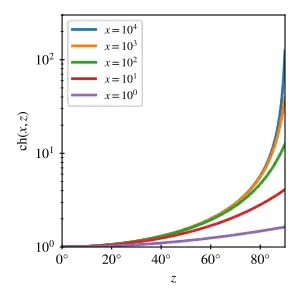
A Chapman function describes the integration of atmospheric absorption along a slant path on a spherical Earth, relative to the vertical case. It applies to any quantity with a concentration decreasing exponentially with increasing altitude. To a first approximation, valid at small zenith angles, the Chapman function for optical absorption is equal to
where z is the zenith angle and sec denotes the secant function.
The Chapman function is named after Sydney Chapman, who introduced the function in 1931.[1]
Definition
In an isothermal model of the atmosphere, the density varies exponentially with altitude according to the Barometric formula:
- ,
where denotes the density at sea level () and the so-called scale height. The total amount of matter traversed by a vertical ray starting at altitude towards infinity is given by the integrated density ("column depth")
- .
For inclined rays having a zenith angle , the integration is not straight-forward due to the non-linear relationship between altitude and path length when considering the curvature of Earth. Here, the integral reads
- ,
where we defined ( denotes the Earth radius).
The Chapman function is defined as the ratio between slant depth and vertical column depth . Defining , it can be written as
- .
Representations
A number of different integral representations have been developed in the literature. Chapman's original representation reads[1]
- .
Huestis[2] developed the representation
- ,
which does not suffer from numerical singularities present in Chapman's representation.
Special cases
For (horizontal incidence), the Chapman function reduces to[3]
- .
Here, refers to the modified Bessel function of the second kind of the first order. For large values of , this can further be approximated by
- .
For and , the Chapman function converges to the secant function:
- .
In practical applications related to the terrestrial atmosphere, where , is a good approximation for zenith angles up to 60° to 70°, depending on the accuracy required.
See also
References
- 1 2 Chapman, S. (1 September 1931). "The absorption and dissociative or ionizing effect of monochromatic radiation in an atmosphere on a rotating earth part II. Grazing incidence". Proceedings of the Physical Society. 43 (5): 483–501. Bibcode:1931PPS....43..483C. doi:10.1088/0959-5309/43/5/302.
- ↑ Huestis, David L. (2001). "Accurate evaluation of the Chapman function for atmospheric attenuation". Journal of Quantitative Spectroscopy and Radiative Transfer. 69 (6): 709–721. Bibcode:2001JQSRT..69..709H. doi:10.1016/S0022-4073(00)00107-2.
- ↑ Vasylyev, Dmytro (December 2021). "Accurate analytic approximation for the Chapman grazing incidence function". Earth, Planets and Space. 73 (1): 112. Bibcode:2021EP&S...73..112V. doi:10.1186/s40623-021-01435-y. S2CID 234796240.
External links
- Chapman function at Science World
- Smith, F. L.; Smith, Cody (1972). "Numerical evaluation of Chapman's grazing incidence integral ch(X,χ)". J. Geophys. Res. 77 (19): 3592–3597. Bibcode:1972JGR....77.3592S. doi:10.1029/JA077i019p03592.